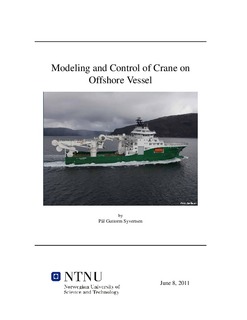| dc.contributor.author | Syvertsen, Pål Guttorm | nb_NO |
| dc.date.accessioned | 2014-12-19T12:06:40Z | |
| dc.date.available | 2014-12-19T12:06:40Z | |
| dc.date.created | 2012-02-08 | nb_NO |
| dc.date.issued | 2011 | nb_NO |
| dc.identifier | 493052 | nb_NO |
| dc.identifier.uri | http://hdl.handle.net/11250/237968 | |
| dc.description.abstract | This master thesis is about modeling and control of crane placed on an offshore vessel. An active heave compensating crane, designed by MacGregor, has been used as a basis for developing the crane model. Cranes of this type are placed on a wide variety of vessels and operate all over the world. Besides MacGregor, several other well reputated crane suppliers design similar cranes. In addition, two inverse kinematics control algorithms and three input shapers have been described, implemented and tested in Simulink.
The model of the MacGregor crane was developed mathematically using robot modeling theory. The resulting model was implemented in Simulink and verified both mathematically and against a SimMechanics model. In addition, a cable model and vessel crane interaction were added to the Simulink model. The total Simulink model responded according to expectations during simulations.
Two inverse kinematics algorithms were implemented and tested. Both had vessel kinematics incorporated. As a result, these two algorithms enabled the crane to counteract the vessel motion. This control method is also of interest to operators. It enables the them to control the crane in the workspace, instead of in the joint space. Simulations show that the two inverse kinematics algorithms were able to keep the crane tip at a fixed point in an earth fixed reference frame. However, in sea state 6 the vessel motion was fluctuating to fast, making the crane unable to keep the crane tip at a fixed point.
The input shaping control algorithm shapes the control input given from the operator in a manner that makes the crane stop at any point with reduced payload swing. The effect of increasing the robustness of the shaper was checked using three different shapers. Simulations showed that the input shapers were able to reduce the residual vibration.
For a 5 meter long cable, the zero vibration shaper reduced the residual vibration from 1 meter to approximately 20 cm, whereas the zero vibration derivative shaper reduced the vibration to about 5 cm. The zero vibration derivative derivative shaper was able to reduce the vibration to about 2.5 cm.
| nb_NO |
| dc.language | eng | nb_NO |
| dc.publisher | Norges teknisk-naturvitenskapelige universitet, Fakultet for ingeniørvitenskap og teknologi, Institutt for marin teknikk | nb_NO |
| dc.title | Modeling and Control of Crane on Offshore Vessel | nb_NO |
| dc.type | Master thesis | nb_NO |
| dc.contributor.department | Norges teknisk-naturvitenskapelige universitet, Fakultet for ingeniørvitenskap og teknologi, Institutt for marin teknikk | nb_NO |
